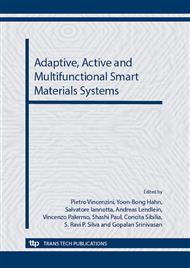p.258
p.266
p.270
p.276
p.280
p.285
p.291
p.297
p.302
Cobalt Doped ZnO Nanorods Fabricated by Chemical Bath Deposition Technique
Abstract:
ZnO nanorods are currently studied for variety optoelectronic applications. Typically, thin film and bulk ZnO show a strong light absorption in the ultra violet (UV) range. For devices that operate in the visible and infrared range such as optoelectronic sensors and photovoltaic cells, it is necessary to modify the absorption profile from UV to higher wavelengths in the visible region. In this study we investigate optical absorption of ZnO nanorods doped with cobalt using a modified chemical bath deposition technique. The light absorption properties of Cobalt doped ZnO nanorods were studied using Photoluminescence (PL) and Raman Spectroscopy. For doping of Cobalt ranging from 3 to 10 percentage of the total weight, the PL intensity shows a suppression of the prominent UV peak at 383 nm with increase in doping concentration. This reduction in PL intensity at 383 nm is accompanied by an increase in the PL intensity at 429 nm and 469 nm. We will discuss details of ZnO-Cobalt structures using Raman spectroscopy on cobalt doped ZnO nanorod samples of 1 -20% doping concentration.
Info:
Periodical:
Pages:
280-284
Citation:
Online since:
September 2012
Authors:
Keywords:
Price:
Сopyright:
© 2013 Trans Tech Publications Ltd. All Rights Reserved
Share:
Citation:


